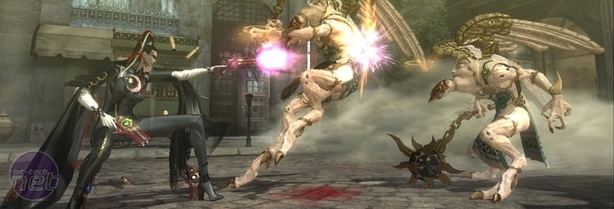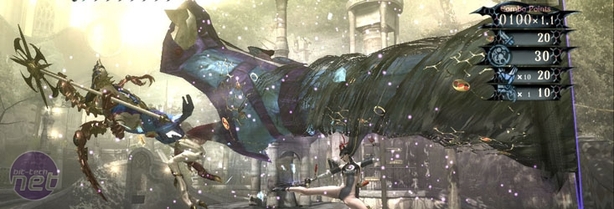
Bayonetta Review
Publisher: SegaPlatforms: Xbox 360, PlayStation 3
UK Price (as reviewed): ₤39.99
US Price (as reviewed): $55.98
You know that age old story: Girl wakes up after 500 years at the bottom of a lake; girl punches angels repeatedly in the face. It’s the same coming-of-age tale that’s been repeated for aeons.
Bayonetta is two things. Bayonetta is brilliant; likely one of the best examples of a videogame that brings its own genre to the very top of its game. It’s that perfect marriage of theatrical action and sleekly precise character design, all tied together with numerous references to the history of video games.
It’s also bloody convoluted.
Bayonetta is the story of a leggy witch at war with a rival clan, who unfortunately at some point gets stuck at the bottom of a lake for a few centuries. When she wakes up she’s lost her memory but still retains her witch powers. She becomes part of a motley crew involving a supernatural bar-owner and an informant played by Joe Pesci’s doppelganger, and continues fighting angels to keep herself from being dragged to Inferno: a Hell-dimension with a partial relation to Dante’s Divine Comedy.
Then there’s the subplot about the persistent journalist from another dimension. The mind boggles, but to be fair, this confusion is largely a staple of the genre and worth pointing out if only because it's one of the exceptionally few elements that isn’t as easily accessible and streamlined as the rest of Bayonetta. However, even with a nonsense storyline hammed up to extreme for fans of this genre, these elements are completely secondary next to the adrenaline fuelled gameplay.
Coming straight out of the Lara Croft School of Incredibly Fit and Lethal Female Leads, Bayonetta the character is stretched to her most fun, cartoonish and indulgent conclusion. Many have highlighted her sultry, femme fatale qualities but you can essentially do as much justice to her by imagining a sort of lanky, Sarah Palin-faced sex kitten if she were played by Brandon Lee in The Crow. She’s what’s enticing about videogame and pop cultural figureheads; larger-than-life, confident, funny, and memorably weird-looking.
It would be crass to just call her eye candy when in reality she’s a brilliantly crafted design. Even in stand-by mode you can see the level of detail put into her character. From her butterfly wings that are only visible in a fluttery shadow under her feet to the headstrong Mick Jagger swagger she projects entirely through a hand-on-hip stance, she exudes personality and presence even without saying a word. That’s no simple feat when she’s nearly always surrounded by a flurry of action that threatens to swallow the scene.
From the offset Bayonetta is an astonishingly responsive conduit for the combat system too. Being all legs and waist might single her out as an example of slightly sexist character design, but hell, they have their uses. Exaggerated limbs end up turning each combat move into a floating, sweeping ballet of perfection, setting her apart from the blur of hard action on the screen and bringing subtly graceful aesthetics to a hack-and-slash canvas.
Her offensive moves are a basic combination of punches and kicks that are automatically strung together, but the sheer amount of possible combinations should make your thumbs callous in disbelief: Quite literally hundreds of combos with each weapon given its own individual list of moves. To help you get a grasp of the process, the game’s loading screens display each of your inputs and the number of times each combination was played. Throughout the action you’ll be filling your combo meter, allowing you to gain access to Torture Attacks – massive and hilarious blows of strength, with each attack relative to who you’re up against. They all play out in their own surprisingly innovative and bloody manner: a sort of buffet-offering of iron maidens, guillotines, and mid-air impaling.
However, it’s Witch Time that is probably the foremost stand-out aspect of combat. Essentially this is just a way to slow down time; a variation on the Bullet Time features we’ve become used to. But the crowning difference is that you can initiate this as often as you can manage it, by evading oncoming hits at the very last second. This allows you to spam combination after combination mid-combat as the enemies around you thrash in slow motion, and more importantly shifts the entire rhythm of the action. Witch Time naturally brings the fight to its cinematic height, but its best feature is how seamlessly this kind of combat style fits to the personality of the character, making it feel like an extension of Bayonetta’s sly and hard-biting sense of humour by adding yet another way she can toy with oncoming enemies.

MSI MPG Velox 100R Chassis Review
October 14 2021 | 15:04











Want to comment? Please log in.